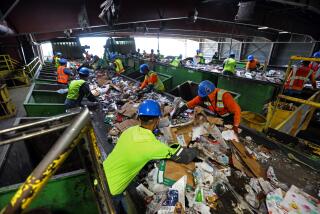Study Finds Genital Abnormalities in Boys
- Share via
Scientists studying the effects of hormone-mimicking chemicals on humans have reported that compounds called phthalates, used in plastics and beauty products and widely found in people, seem to alter the reproductive organs of baby boys.
In the first study of humans exposed in the womb to phthalates, the researchers, who examined the genitalia of male babies and toddlers, found a strong relationship between the chemicals and subtle changes in the size and anatomy of the children’s genitals. Phthalates are ubiquitous compounds used as softeners in plastics and to maintain color and fragrance in beauty products such as nail polish and perfume, among other uses.
For the record:
12:00 a.m. May 28, 2005 For The Record
Los Angeles Times Saturday May 28, 2005 Home Edition Main News Part A Page 2 National Desk 1 inches; 54 words Type of Material: Correction
Genital abnormalities -- An article in Friday’s Section A about a study linking phthalates, compounds used in plastics and cosmetics, with genital abnormalities in boys stated that Europe had prohibited using phthalates in cosmetics. Europe has banned two major types of the compounds in cosmetics, but other phthalates are still legal in the products.
It is the first time that scientists have shown that any industrial compound measured in mothers’ bodies seems to disrupt the reproductive systems of their babies.
But many experts, including the authors of the report published today in the online version of the journal Environmental Health Perspectives, say that more research must be done to determine if the genital abnormalities in the boys lead to fertility or health problems and to prove that they are caused by phthalates.
The findings were based on tests of 85 mothers and sons, averaging nearly 13 months of age, born in Los Angeles, Minneapolis and Columbia, Mo. Mothers with the highest levels of chemicals in their urine late in their pregnancies had babies with a cluster of effects. The span between anus and penis, called anogenital distance, was comparatively short, and the infants had smaller penises and scrotums and more instances of incomplete descent of testicles.
Medical experts do not know whether babies with those physical characteristics will later develop reproductive problems. But in newborn animals, laboratory studies show that that combination of effects can lead to lower sperm counts, infertility, reduced testosterone and testicular abnormalities when they mature.
“In rats, it’s called the phthalate syndrome. What we found for the first time is evidence for this syndrome in humans,” said Dr. Shanna Swan, the study’s lead researcher and a professor in the Department of Obstetrics and Gynecology at the University of Rochester School of Medicine and Dentistry. “Animals [exposed to phthalates] definitely have decreased testosterone, so it is likely that this is happening in humans too.”
The study is the strongest evidence yet that man-made chemicals in the environment can feminize male babies in the womb.
Yet scientists say a larger study of babies should be conducted, and that they should be followed into adulthood to see whether they develop low sperm counts or any other reproductive problems.
“It’s such an important observation, you’d like to see this done again with more children and another population,” said Earl Gray, a U.S. Environmental Protection Agency reproductive toxicologist whose research has found that phthalates feminize male rodents.
“And we would like to see what the consequences are when they reach adulthood,” Gray said. “We don’t know the significance of this effect on the children later in life, but we do know the effect on rats.”
“The main thing is this is a very small group of subjects. It is too early to say whether there are long-term effects, and whether this [anogenital] measure is important or not in humans,” said Dr. Catherine Mao, a co-author and pediatric endocrinologist at the Los Angeles Biomedical Research Institute at Harbor-UCLA Medical Center.
Reproductive biologists say that a shorter anogenital distance is a female-like effect in animals, a telltale sign of decreased male hormones, and that it is likely that the human effects are similar, because hormones function the same in animals and people.
If a child has a shorter anogenital distance, “you are very likely going to see changes in every other aspect of masculinization as well,” said Frederick vom Saal, a reproductive toxicologist at the University of Missouri at Columbia.
Toxicologists have known since the early 1990s that some pesticides and industrial compounds, including phthalates, can mimic estrogen or block testosterone, the female and male sex hormones that control reproductive development. While they have found effects on the genitalia of laboratory animals and wildlife, they have been uncertain whether exposure to the fake hormones affects humans.
Some medical experts suspect that chemicals are responsible for reduced sperm counts that have been reported in much of the developed world, as well as increases in testicular cancer and cryptorchidism, or undescended testes. Three previous studies of men, two in the Boston area and one in India, linked phthalates to low sperm quality.
Swan, who is among the world’s foremost experts on the effects of contaminants on the male reproductive system, reported in the late 1990s that a review of sperm counts in developed nations showed a substantial decline since World War II, when many synthetic pesticides and industrial compounds were produced. Also, in 2003, she found lower sperm quality in men exposed to widely used agricultural herbicides.
Swan said her team found “a cluster of small genital changes” associated with low-dose exposure to four phthalates.
One of the most important findings was that the phthalate levels associated with the genital changes “were not unusually high” for the general population, according to the study, which was funded by the National Institutes of Health and the EPA.
Nearly everyone in a 1999-2000 survey of 2,500 people throughout the United States had phthalates in their urine, and the effects in the babies were seen at concentrations below those detected in the urine of 25% of them, according to the results of the testing by the Centers for Disease Control and Prevention.
Some scientists specializing in reproductive health say that finding anatomical changes in infants related to a chemical is disturbing, even if their health is not shown to be affected.
But Marian Stanley, manager of a phthalates panel at the American Chemistry Council, said the authors did not report any negative health effect on the babies, and that the differences in their genitalia have “no known significance” and could be caused by natural variability, not chemical exposure.
“As of now, the authors have yet to demonstrate that their data are solid, or that they are meaningful,” Stanley said.
Several scientists ruled out the Chemistry Council’s assertion that the results could be due to natural variations in boys. Kim Boekelheide, a professor at Brown University’s department of pathology, who studies the testicular effects of phthalates on animals, said the associations between the chemicals and the babies’ genital effects “are strikingly strong. Overall, this is a very important study.”
Boys exposed to the highest levels of the chemicals were 4 to 10 times more likely to have the genital changes. The Los Angeles-area mothers were patients of prenatal clinics at Harbor-UCLA Medical Center and Cedars-Sinai Medical Center.
Swan emphasized that none of the abnormalities was serious enough to be considered birth defects.
Dr. Larry Lipshultz, a professor of urology at Baylor College of Medicine in Houston, said there is no “normal” anogenital length for boys. It is measured often in lab animals, and sometimes in girls, but rarely in boys.
“Is the effect really a significant effect?” Lipshultz said. “The difference is in millimeters. The problem is that no one has ever done this before. It is interesting and suggestive, but until larger populations are studied, it does not prove that phthalates are causing these effects in male genitalia.” The boys were not all the same age, varying from 3 to 26 months, and even though the researchers tried to correct for that, it could have made the comparisons of genitalia imprecise, said Dr. Rebecca Z. Sokol, a professor of gynecology and medicine at the Keck School of Medicine at USC.
“The importance [of this study] is there is an anatomic abnormality which might be associated with in utero exposure to phthalates.... But there are a lot of unanswered questions in this study,” Sokol said.
The Food and Drug Administration has said there is no evidence phthalates are unsafe. Manufacturers are not required to notify consumers when phthalates are in their products, and their use is unregulated in the United States. Europe, however, has banned them in baby toys and cosmetics.
The California Senate is expected next week to hear a bill that would require cosmetics manufacturers to disclose to state health officials whether their product contained carcinogens or reproductive toxins. Another bill to ban phthalates and another compound called bisphenol A in children’s products is pending in the Assembly’s Appropriations Committee.
Mao said she feared overreaction by the public in seeking a ban on phthalates. “What we need to have is more data,” she said. “I don’t think we should remove these products yet. Some things we use to substitute for them may be worse.”






